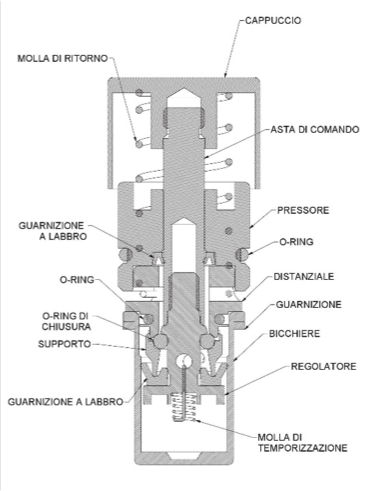Everything you need to know for the correct installation and maintenance of self-closing taps

Self-closing taps are designed to automatically shut off the flow of water after a pre-set time, ensuring both water and energy savings in the premises in which they are installed.
In public facilities, the installation of self-closing taps is a compulsory requirement and mechanical self-closing taps are certainly the least expensive option for lower budgets.
But how do they work? How are they installed? How are they maintained? These are the most frequent questions received by our engineering department which we are looking to answer in this article.
HOW DO THEY WORK?

Stage 1: When the self-closing tap is pressed, the lower lip seal empties the chamber beneath it and, concurrently, the closing O-ring loses its seal allowing water to flow towards the spout.
Stage 2: Upon releasing the pushbutton, the return spring creates a negative pressure beneath the lower lip seal. The pressure unbalance between the two areas at the lower lip seal is equalized through the time-delay hole and spring. The passage gap between these two components creates a tiny channel of water that fills the lower chamber, rebalancing pressure and allowing for the tap to go back up and close. The time it takes for the chamber beneath the lower lip seal to fill corresponds to the time it takes for the tap to self-close.
HOW ARE THEY INSTALLED?
Installation of self-closing taps is no different from standard single-control taps. We only need to be more careful in connecting the self-closing tap to the plumbing system.
First of all, we need to make sure that water quality is compliant with standard UNI 8065:1989, laying down the chemical and physical parameters of water quality in civil water heating systems. Compliance with this standard will ensure that the best water quality is supplied to the tap.
When connecting the tap for the first time, always purge the system first, to avoid damage caused by internal debris.
At first connection, it is also important to prevent pressure surges, so as to avoid lifting any heavy debris that may be still present in the piping or generating any water hammering that could damage the system and/or the tap. Should the tap remain unused for a long period of time, it is advisable to empty the system first, so as to prevent
HOW ARE THEY MAINTAINED?
Maintenance of self-closing taps is no different from standard taps. Cleaning once a year is recommended. The cartridge is designed for self-cleaning during operation. Cleaning is regarded as an optional activity which, however, will help extend tap life.
Click on the link below for a video showing how to clean a self-closing cartridge:
Valerio Lai
Head of Engineering Department










